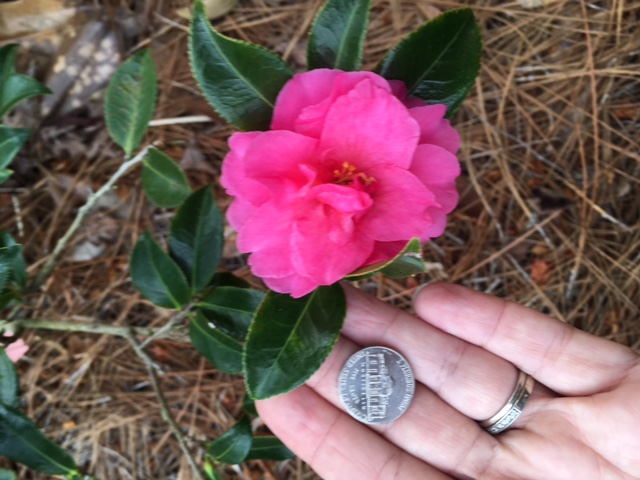
by Julie McConnell | Jan 17, 2017
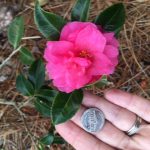
Winter flowers and small leaves with serrated edges lead to identification as Camellia sasanqua. Photo: J_McConnell, UF/IFAS
A common diagnostic service offered at your local UF/IFAS Extension office is plant identification. Whether you need a persistent weed identified so you can implement a management program or you need to identify an ornamental plant and get care recommendations, we can help!
In the past, we were reliant on people to bring a sample to the office or schedule a site visit, neither of which is very practical in today’s busy world. With the recent widespread availability of digital photography, even the least technology savvy person can usually email photos themselves or they have a friend or family member who can assist.
If you need to send pictures to a volunteer or extension agent it’s important that you are able to capture the features that are key to proper identification. Here are some guidelines you can use to ensure you gather the information we need to help you.
Entire plant – seeing the size, shape, and growth habit (upright, trailing, vining, etc.) is a great place to begin. This will help us eliminate whole categories of plants and know where to start.
Stems/trunks – to many observers stems all look the same, but to someone familiar with plant anatomy telltale features such as raised lenticels, thorns, wings, or exfoliating bark can be very useful. Even if it doesn’t look unique to you, please be sure to send a picture of stems and the trunk.
Leaves – leaf color, size and shape is important, but also how the leaves are attached to the stem is a critical identification feature. There are many plants that have ½ inch long dark green leaves, but the way they are arranged, leaf margin (edges), and vein patterns are all used to confirm identification. Take several leaf photos including at least one with some type of item for scale such as a small ruler or a common object like a coin or ballpoint pen; this helps us determine size. Take a picture that shows how leaves are attached to stems – being able to see if leaves are in pairs, staggered, or whorled around a stem is also important. Flip the leaf over and take a picture of the underside, some plants have distinctive veins or hairs on the bottom surface that may not be visible in a picture taken from above.
Flowers – if flowers are present, include overall picture so the viewer can see where it is located within the plant canopy along with a picture close enough to show structure.
Fruit – fruit are also good identification pictures and these should accompany something for scale to help estimate size.
Any additional information you are able to provide can help – if the plant is not flowering but you remember that it has white, fragrant flowers in June, make sure to include that in your description.
Learning what plants you have in your landscape will help you use your time and resources more efficiently in caring for you yard. Contact your local UF/IFAS Extension office to find out who to send requests for plant id.
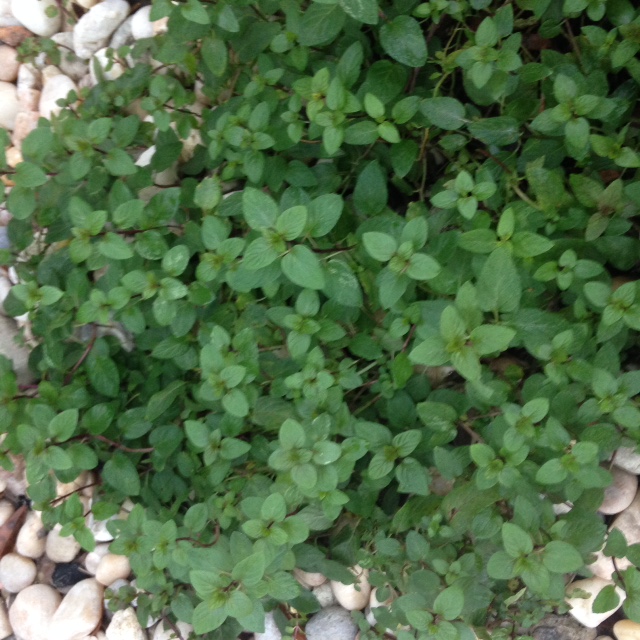
by Julie McConnell | Aug 12, 2016
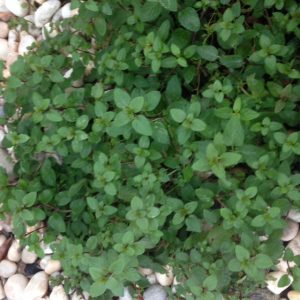
Chocolate mint has fragrant, dark green foliage and works well as a groundcover. Photo: Julie McConnell, UF/IFAS
Mint is very easy to grow in the right place, sometimes a little bit too easily. It’s reputation for being aggressive is well deserved. As with any other plant you use in your landscape, you need to be sure you have the right plant for the right place and there just might be such a spot in your garden for mint!
Garden areas with part sun/part shade and moist soil are perfect environments for mint. Like most herbs, it does not require much fertilizer and there are very few insects that bother it. Because mint forms runners where it touches the ground it is an ideal plant to use in areas that need soil stabilization as the dense growth habit will prevent erosion and sediment runoff.
Mint grows rapidly in the right conditions and can spread further than a gardener might want. However, it is not difficult to manage with a little maintenance. Because the plant is herbaceous rather than woody, it can be pulled or trimmed with little effort. Another method to keep it in bounds is to chemically edge using an herbicide on the portions that are growing beyond the bed border. Just keep in mind that if you plan to use your mint in food or drink you should only use chemical products labeled for edible crops and follow all label instructions closely.
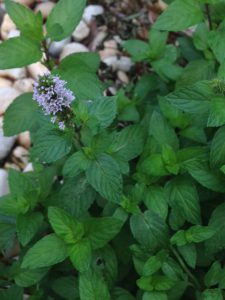
Mint flowers are attractive to pollinators. Photo: Julie McConnell, UF/IFAS
There are many different mints available such as chocolate mint, spearmint, and peppermint. Each has a slightly distinct flavor and may have different sized leaves or coloration. Mints are prolific bloomers and are attractive to pollinators such as bees and beneficial wasps.
To read more about mints please see http://gardeningsolutions.ifas.ufl.edu/plants/edibles/vegetables/mint.html
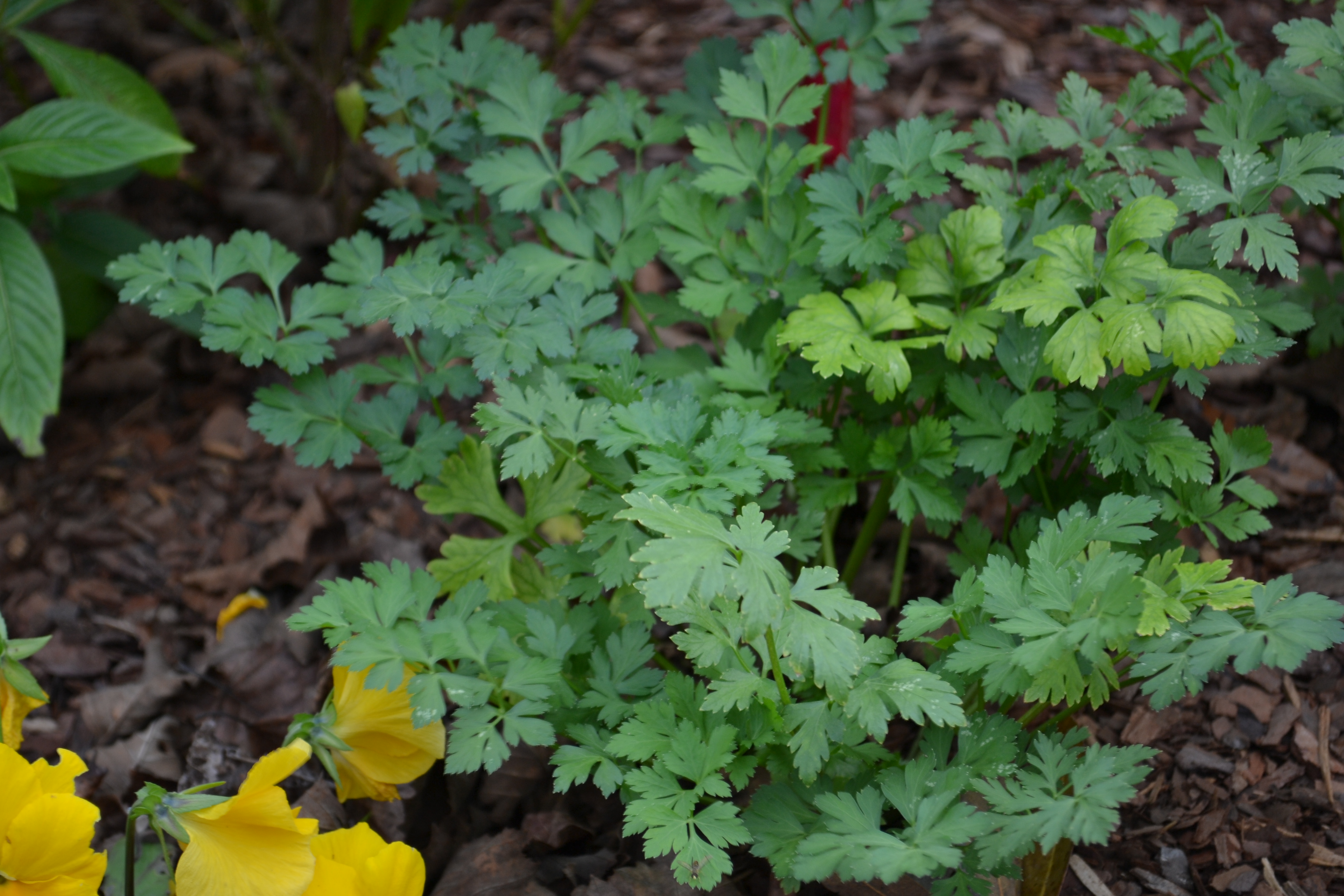
by Beth Bolles | Jan 27, 2016
Parsley is one of the most well-known herbs, and if you missed the fall planting, there is still time to choose a preferred selection for late winter/spring planting.
An herbaceous biennial, parsley is an easy herb for containers or small garden spaces. You may purchase a small pot at the nursery or grow from seed. Realize that seeds do best when soaked in warm water for 24 hours prior to planting and may not germinate for several weeks. Be sure to mark the area well so you remember not to overplant with another herb or vegetable.
Choose an area or soil that allows for good drainage and full sun in the cooler months. During the heat of summer, parsley does prefer a little break from afternoon sun. Consider planting in pots so plants can be moved during the hottest months. Plants will prefer water during times when rainfall is lacking, but the taproot does allow the plant to survive some drought.
There are different types of parsley you may choose but the most common types sold in stores are the curled leaf parsley and the Italian parsley. The Italian parsley has a stronger flavor and holds up a little better during cooking.
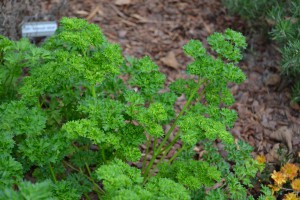
Curled leaf parsley
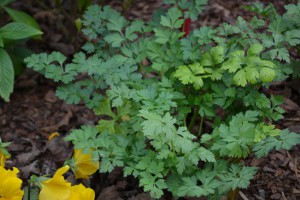
Italian parsley
Parsley is an attractive plant as a garden border or in a mixed container but will likely have a visitor during the warmer season that will feed on the leaves. The black swallowtail butterfly will use parsley as a host plant so plant enough to share with the butterflies.
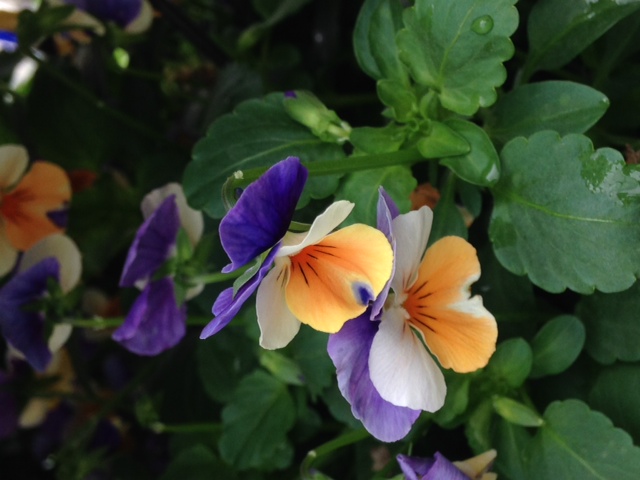
by Julie McConnell | Nov 24, 2015
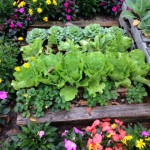 You may have heard “group plants with similar needs together” but struggled to come up with some combinations that work. The most important things to consider when creating functional garden space is the cultural needs of the plants you want to combine. Sunlight, water, and fertilizer needs should be very similar when planting multiple plants together. For fall and winter gardens, choose annuals that are frost tolerant and/or evergreen perennials.
You may have heard “group plants with similar needs together” but struggled to come up with some combinations that work. The most important things to consider when creating functional garden space is the cultural needs of the plants you want to combine. Sunlight, water, and fertilizer needs should be very similar when planting multiple plants together. For fall and winter gardens, choose annuals that are frost tolerant and/or evergreen perennials.
Here are some plants that work well together in cool weather:
- Strawberries and romaine lettuce – both are cool season annuals that can be planted in late October or early November. The lettuce can be harvested from outside leaves after growth begins or let it form a head and cut the entire plant. Strawberries will spread out but remain fairly low growing compared to the upright lettuce. These plants combine well in a container if given room to expand.
- Rosemary and oregano – these culinary herbs thrive in sunny, well-drained spots. Rosemary is an upright woody perennial and oregano spreads along the ground making a fragrant groundcover for a tough spot.
- Snapdragons, pansies, and parsley – this combination gives foliage contrasts in addition to colorful flowers. This combination will work in full sun or a slightly shaded spot in th
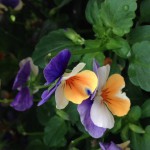 e garden. In the spring, replace the snapdragons and pansies for warm season annuals for continued color.
e garden. In the spring, replace the snapdragons and pansies for warm season annuals for continued color.
- Cabbage, cauliflower, and strawberries – all cool season edible crops that have attractive foliage and similar needs.
- Snapdragons, violas, and petunia – this colorful combination has three height levels of tall snaps, bunching violas, and trailing petunias.
To learn more about these plants and other options Growing Strawberries in the Florida Home Garden, Herbs in the Florida Garden, and Gardening with Annuals in Florida.
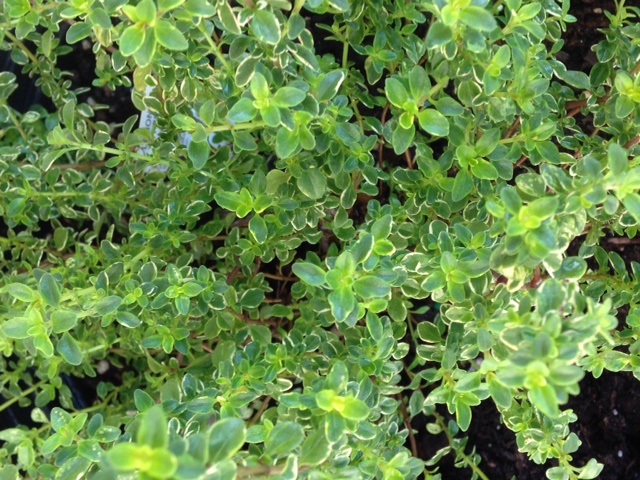
by Julie McConnell | Oct 27, 2015
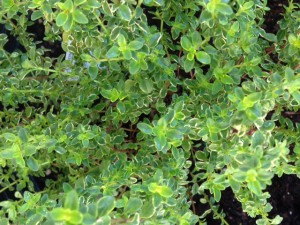
Variegated lemon thyme. Photo: JMcConnell, UF/IFAS
If you have ever thought about gardening but feel too intimidated to give it a try, consider starting with a herb garden!
Culinary herbs are generally very easy to grow and very forgiving of the neglectful gardener. They have relatively few pest or disease problems and thrive in hot climates on poor soils. An added benefit of growing herbs is that some parts are edible and can really liven up a plain dish.
Just like with other plants, there are both annual and perennial herbs. Annuals only live for one season and will need to be replanted or allowed to go to seed for the next season’s plant. An example of an easy to grow herb with an annual life cycle is basil. Basil comes in many different flavors and can be purchased as a transplant (small plant) or grown from seed. It performs well in warm weather and will be killed by a hard frost. Basil grows well in part to full sun and when it flowers it is attractive to bees and other pollinators. If you allow it to go to seed, you will have more plants throughout the growing season and more the following year.
Some perennial herbs that are easy to grow are rosemary, thyme, and mint. All of these plants can live for many years in the home garden. Rosemary and thyme like sunny spots but have very different growth habits. Rosemary will grow into a large woody shrub while thyme is low growing and hugs the ground. Both like full sun and good drainage. Another perennial herb that fits into shady sites with moist soil is mint. Mint has a vining habit and can either trail over the edges of pots or can form a dense mat in a flower bed. It will root wherever the stem touches the ground, so it is also easy to divide plants and share with friends.
To learn more about herbs read Herbs in the Florida Garden or attend our upcoming class “More Cooking With Herbs” where you will learn how to grow and cook with them! Class will be held on Saturday, November 14th from 9 a.m. – 12 noon. Pre-registration and payment of $10 is required no later than November 9th to attend the class. For more details or to register, call our office at 850-784-6105.
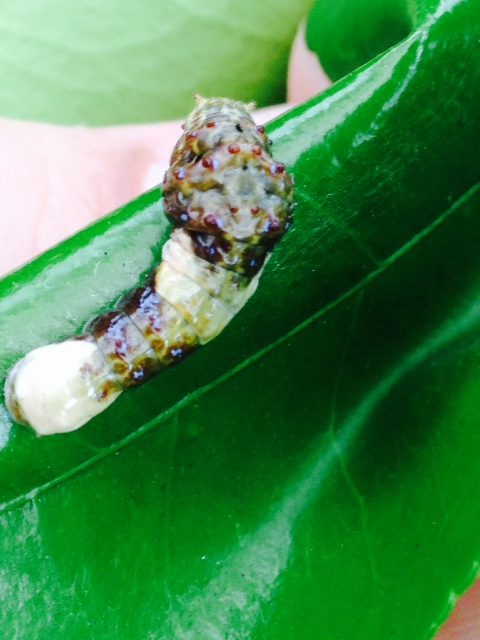
by Julie McConnell | Sep 29, 2015
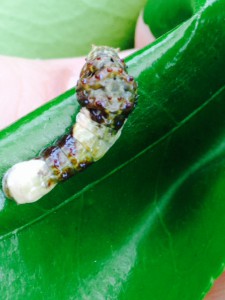
Giant Swallowtail on citrus leaf. JMcConnell, UF/IFAS
Adult butterflies are pretty easy to attract to your landscape if you provide flowering plants, but getting them to lay eggs in your garden is a little trickier.
Butterflies go through complete metamorphosis which means that they have four main life stages. The first is the egg, second they hatch into caterpillars (larvae) which feed and molt many times, the third stage is the pupa or chrysalis, and finally they emerge as colorful adults. Complete metamorphosis is considered a more advanced life cycle than incomplete and one of the reasons is because most insects that go through this process do not compete for food at different life cycles. For example, the gulf fritillary butterfly larvae needs passionflower (Passiflora spp.) to feed on – no other plant type will do. The adults visit many flowering landscape plants such as zinnias, butterfly bush, pentas, etc. The adults are feeding on nectar while the caterpillars are eating foliage.
Because the larvae are very host specific, you must offer the correct plant to attract particular butterflies. Luckily, we have many options in the Florida panhandle! Just remember if you would like to attract butterfly breeding to your yard, you must sacrifice some foliage to support the caterpillars.
• Gulf Fritillary – Passionflower
• Monarch – Native milkweed
• Giant Swallowtail – citrus
• Eastern Black Swallowtail – plants in the carrot family including dill, celery, fennel, and parsley
• Tiger Swallowtail – sweet bay magnolia, tulip poplar, black cherry
• Zebra Swallowtail – pawpaw
• Luna Moth – walnut, hickory, sweetgum, persimmon, winged sumac
If you would like to know more about individual butterfly species please visit UF/IFAS Entomology & Nematology’s Featured Creatures website.











 e garden. In the spring, replace the snapdragons and pansies for warm season annuals for continued color.
e garden. In the spring, replace the snapdragons and pansies for warm season annuals for continued color.


